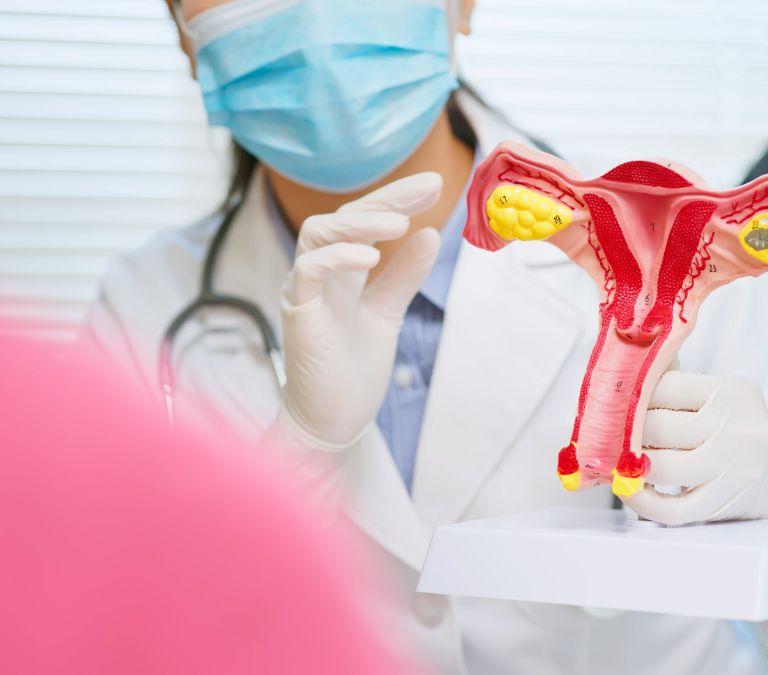Experience with menopausal symptoms varies with each woman, as with her usual menstrual cycle, which occurs during the reproductive years. While some women may start the menopausal stage by going through symptoms as early as 40, others may take time to reach theirs, even up to 50 and beyond.
Some of these symptoms experienced by women approaching menopause may include but are not limited to fluctuating menstrual cycles, nausea, breast tenderness, bloating, and headaches. These symptoms are not the same in every woman. Some may experience many problems as they head towards menopause, while others can have very few encounters on their journey. For this reason, you should consult a medical professional to guide what steps to take during such stages.
Before the menopause stage occurs, some women may have started experiencing some mild symptoms for a few years before finally arriving at the menopausal stage, which signals a step into a new phase that is very different from what their body has been used to feeling throughout their years.
Menopause can be frightening for some women to embrace, primarily due to past observations or reviews from other women. This fear should not be the case because, as previously stated, the menopausal stage and symptoms experienced by each woman differ. Just as it is with the stages of pregnancy, the menopausal stage also presents its timing and features.
The menopausal stage ushers in a new sort of development in the woman’s body that deals with the thickening of the endometrium. The endometrium is found in the uterus of the female’s body. It plays a significant role in a woman’s reproductive and menopausal stages.
The thinness or thickening of the endometrium is essential, as it is with every other aspect of the uterine wall, and must also be accorded the same relevance. Issues which may arise from the thickening of the endometrium are not so difficult to figure out as they make themselves visible enough for the woman to detect and get the necessary medical care and attention before it’s too late.
The uterine wall in women is medically referred to as the endometrium or the endometrial stripe. These tissues are present in the uterus, which usually change as you age. When viewed with an ultrasound during the reproductive stage, when the menstrual cycle is experienced, the endometrial stripe is usually skinny when viewed with an ultrasound. As the reproductive cycle progresses, the endometrial line thickens and can sometimes be seen to be layered and appear darker after ovulation.
The general thickening of the endometrium varies with the stage in which the woman is currently at; that is, fluctuation is experienced as the woman grows from puberty up to the age of reproduction and menopause. The endometrial stripe begins its journey during puberty when the young woman begins to grow, and her cells and tissues start their active jobs.
Although at this puberty stage, the endometrial stripe usually appears very thin and may not be detected even with an ultrasound. As was earlier pointed out, during the reproductive phase, the endometrial line varies between thickening and thinning because of the menstrual periods experienced.
The endometrial stripe is thinnest during menstruation due to the shedding of blood experienced monthly. In the postmenopausal stage, the endometrium finally stabilizes and stays thick as no more blood flow in the form of menstruation is recorded, and there is no longer an issue of reproduction except in sporadic cases, which are still yet to be medically proven.
What causes abnormalities in the endometrial tissue?

The endometrium tissue changes more often during the menstrual cycle. The pregnancy period has also been stated as another stage in a woman’s life when the endometrium thickens because there is no menstrual occurrence during the pregnancy period.
A thick or thin endometrial tissue is not a medical concern except in rare cases when some symptoms have been constant, and the woman may feel unhealthy or troubled. Abnormalities in the endometrium tissue may occur when there is thickness and thinness in the tissue. Some of the causes of irregularities in the thickness of the endometrium tissue may include;
- Menstrual periods that are painful for the woman during her reproductive stage
- Pregnancy difficulties
- Short or longer menstrual cycle over 38 days.
- Women who experience heavy bleeding during their menstrual cycle
Symptoms of abnormalities associated with the thinness of the endometrium tissue may include:
- Absence or missed menstrual periods in women of reproductive age.
- Pain experienced during sexual intercourse
- Pain experienced in the pelvic
What happens to the endometrium during perimenopause?
Perimenopause is usually considered as the period when the woman’s reproductive cells transition into menopause, which is a stage when the woman becomes no longer reproductive or can have babies. This stage in most women’s lives has been studied to occur at different ages and times in the woman’s reproductive cycle, and no two women can experience menopause simultaneously.
The menopausal stage does not hit a woman at once but builds up gradually by giving out some symptoms. The symptoms may be evident a few years back before the menopause itself occurs. Most women may not notice these symptoms, which may arise as an irregular menstrual cycle until menopause draws close to its manifestation.
During reproductive age as a woman, the endometrial stripe is usually present in the uterine wall. It appears thin and thick due to the menstrual cycle, which varies in every woman monthly. The endometrial stripe changes in thickness as long as the woman is still reproducing and experiencing the menstrual cycle.
In this way, it is evident that the endometrium plays an essential role in the course of reproduction in every woman, though not many even know about its use. Without the proper functioning of the endometrium, the copy is difficult as there tend to be underlying problems.
During the period between ovulation and the start of the menstrual period, often known as the secretory phase, the endometrium is at its thickest because it accumulates fluid, which allows it to appear with much density. This secretory phase only occurs in women in their reproductive phase, and it ceases to happen once they have passed that stage in their lives. In the early stages of pregnancy, the fertilized egg is implanted into the endometrium at its thickest point. The endometrium continues to guide the fertilized egg and become its home until delivery.
When a woman reaches menopause, her endometrial stripe thickness becomes more stable and does not fluctuate as much as during her reproductive or premenopausal years. The durable consistency seen in the uterine wall has been attributed to the fact that the woman no longer has to shed blood or go through the menstrual cycle for the rest of her life, hence the stability of the thickness of the endometrium tissue.
What happens to the endometrium during menopause?

The endometrium tissue thrives with the production of the hormones estrogen and progesterone. And during menopause, which occurs naturally in women only in rare cases when there are problems, the ovaries produce less estrogen but in proportion to the absence of progesterone, which is usually a problem.
As a woman approaches menopause, the endometrium thickens, ensuring it remains stable when, eventually, menopause sets in. This thickness occurs variably in every woman, but if there are no abnormalities and the woman approaches menopause naturally, the thickness of the endometrium does not need to be measured as it is assumed to be at the proper stage.
What happens to the endometrium after menopause?
Menopause is said to have finally taken place in a woman when she has not experienced any form of bleeding, particularly during the menstrual period or other conditions of blood spots, for one year. If there are forms of bleeding noticed after the menopause period has been certified, you would need to contact your doctor. It will help rule out the possibility of cancer or other serious health issues.
After a woman goes through menopause, the endometrium thickens at a stable measurement of about 5 mm or less, stopping the monthly thinning and thickening of the endometrium tissue as is the case during the reproductive stage of the woman’s life.
As a woman ages, so do her internal reproductive tissues. The ovaries gradually decline in their use and the production of the estrogen hormone. As a person ages, there is a speedy decline in the reproductive process, causing menopause to set in finally.
What causes postmenopausal bleeding in women?
As menopause approaches, the woman is gradually expected to experience bleeding until a final stop. When the stage of menopause has successfully been approached, the woman should not experience even the slightest form of bleeding or spotting—experiencing such needs to be treated by paying a visit to the doctor to carry out the necessary tests.
Postmenopausal bleeding in women can result in many problems that may arise due to underlying health challenges, past medical records, or other medical issues. Some of the postmenopausal bleedings with notable causes can be any of the following:
Polyps: These polyps are noncancerous growths that occur in different parts of the woman’s reproductive system, such as in the woman’s uterus, cervix, or the cervical canal, resulting in bleeding after menopause.
Endometrial hyperplasia: This condition occurs when the lining of the female uterus thickens due to the excessive production of the hormone estrogen while producing very little progesterone. Endometrial hyperplasia occurs when estrogen and progesterone are required to be made in equal amounts, and when there is an imbalance, it can result in bleeding in the woman. Sometimes, women with this medical issue may have obesity or growth of abnormal cells, which may lead to cancer of the uterine lining.
Thinning of the endometrium (endometrium atrophy): in this type of condition, the endometrium tissue in the uterus becomes very thin even after menopause, which is a bad sign as the endometrium is supposed to be thick. The thinning of the endometrium tissue occurs due to the drastic reduction in the production of estrogen, an essential hormone needed in a woman’s body.
Other symptoms or causes of postmenopausal bleeding in women may include infection of the uterus, use of some medications, cancer, etc.
How to check for the cause of postmenopausal bleeding

Vaginal bleeding after menopause is not normal and can be a sign of underlying health problems. Do not ignore this symptom. In some cases, bleeding may occur due to fibroids, polyps, uterine wall disruption, and other factors. Bleeding happens when there is a need for it in the early stages of menopause, but it stops as you progress through the years of menopause. Endometrial cancer is one of the significant issues associated with bleeding in postmenopausal women.
Immediately you notice any form of abnormal symptoms, particularly bleeding or spotting, when menopause ought to have set in, get in touch with your doctor without delay to perform a medical check and carry out the necessary tests to determine the cause of the bleeding. The medical practitioner can perform the physical exam in various ways, some of which are listed below.
Endometrial biopsy: in this method of physical examination, a sample from the uterus is taken out by inserting a thin tube into the woman to get a model, which is sent to the medical laboratory to carry out a further test.
Hysteroscopy: the doctor uses an instrument with a camera and light to examine the woman’s uterus. It is done by inserting the device into the woman’s body to get a clear view of the uterine wall in search of any visible problems.
Transvaginal ultrasound: With an imaging device inserted into the woman’s vagina, the medical practitioner can check for underlying problems and other abnormalities inside the woman’s body.
Dilation and Curettage: your medical preceptor removes some tissue samples from your uterus lining, which is further sent to the medical laboratory for testing, just as it is in the case of the endometrial biopsy, but carried out in a different environment and method.
How can postmenopausal bleeding in women be treated?
If you want to treat the postmenopausal bleeding experienced by women, there is a need to find out the primary cause of the bleeding to know the best solution to apply. Sometimes, surgery may be prescribed as a solution to stop the bleeding process. A doctor can prescribe medications. Either way, it is best to get tested and checked by a doctor to ascertain the cause of the bleeding before any form of help is given in order not to cause further harm to the body.
What is considered a thickened endometrial measurement in a postmenopausal woman?
Generally, there is no purpose for checking the endometrial thickness in postmenopausal women. The only reason why there may be a need for it to be checked may be due to bleeding or the possibility of cancer. When there is no bleeding, the endometrial thickness may also be checked when there is the presence of other unhealthy factors such as obesity, diabetes, polycystic ovarian syndrome, and a history of hypertension.
For postmenopausal women, an endometrial thickness of less than or equal to 5 mm is termed normal, and those with an endometrial thickness greater than 5 mm are considered abnormal. An ultrasound is usually used to measure the thickness or thinness of the endometrium, where a medical expert can also check for irregularities or other problems in the endometrium.
What is endometriosis?
Endometriosis is a medical condition associated with the uterine wall and tissue growing in other parts of the female body, such as the fallopian tubes, ovaries, and bowel. Endometriosis is usually common for women between 30 and 40, but it can also occur in older women, which is very rare. This condition creates a lot of pain and depression for the woman, making her feel uncomfortable until treated. Some of the common symptoms of a woman going through endometriosis include:
- Pelvic pain
- Lower back pain
- Pain after or during sexual intercourse
- Pain experienced during bowel movements
Before now, people argued that endometriosis only occurs in women of reproductive age, but some findings have also been made to ascertain that some older or postmenopausal women can also experience this medical condition. Endometriosis offers a significant risk of malignant transformation in the uterus, which has not been able to provide a prevalent cure for the affected person.
The primary cause of endometriosis is unknown, but some medical theories suggest it is caused by retrograde menstruation, which occurs when menstrual blood flows directly back to the fallopian tubes rather than out through the vagina as it should. Another theory states that endometriosis occurs due to the hormone transformation outside the uterus lining, making it have similar cells to that outside, also known as endometrial cells.
Endometriosis occurs in four major stages: minimal, mild, moderate, and severe, which all occur in various locations, numbers, and sizes depending on the level or depth of the endometriosis.
Endometriosis has no known cure medically, but it can be managed if the symptoms are discovered early. Sometimes, surgical procedures and medication are offered to help reduce the symptoms and pain experienced, but none has yet to show a laid-out cure for the disease.
It is best to communicate with your medical practitioner to find out what works best for your symptoms because women have shown varying reactions to treating the symptoms of endometriosis, and no two people are the same. This disease can take up a whole lot of the person’s mental strength, but early detection can go a long way in helping to ease and manage the disease to a reasonable level.
Also, finding a medical support group to help educate and stay in the know about what to do with the endometriosis symptoms can go a long way in managing the disease and your mental state. There are medical groups that you can contact either through your medical practitioner or online to have people to share ideas and bond with through the struggle.
Final thoughts
Endometrial tissue is an essential and fragile part of a woman’s reproductive system as it plays a critical role in ascertaining if a woman has a healthy uterus or not. Many studies have shown that women approaching menopause can go through their stages easily and as naturally as possible without underlying medical problems.
The thickness and thinness of the endometrial lining are also essential, and it has been discovered that the endometrium thickens more during pregnancy and menopause. Menopause is the final stage of the fluctuating process of the endometrium. The thinness is usually more observable during the menstrual cycle due to the shedding of blood monthly.
A healthy endometrium means a healthy and safe uterus that allows the woman to age without problems. The menopausal stage is one that every woman must go through, which should be in good health and not accompanied by other medical issues.







